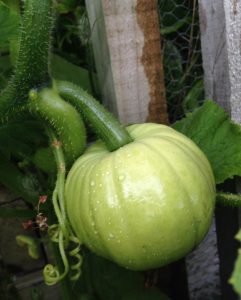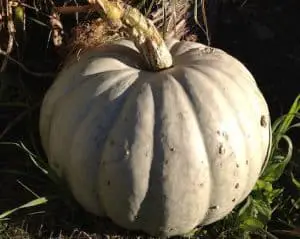Growing big pumpkins is a fantastic hobby that many backyard farmers seem to be into these days. The astronomical sizes we’ve seen some of them grow into are simply jawdropping. Calling it a hobby seems to be a mild way to put it as it is now a full-fledged profession as people earn a pretty penny from it. One seed from these large-sized pumpkins could go for as much as $1200.
So, whether it’s a newfound hobby for you, you’re planning to have a huge Jack O’lantern, or you’d like to go into this profession, then this article is for you? We’ll be discussing everything you need to know to grow champion-sized pumpkins.
Pumpkin Basics

First off, let’s cover the basics you need to know before planting a pumpkin seed.
It’s a Fruit: Let’s put an end to the debate regarding if pumpkins are fruits or vegetables. According to botanists worldwide, it is a fruit. By definition, a fruit is formed from flowering plants. However, because pumpkins taste savory rather than sweet we think it’s a vegetable. But newsflash everyone, not all fruits are sweet. Even avocados are considered to be fruits.
Method of Propagation: Since we’ve clarified that it’s a fruit, you can take a wild guess to proclaim that it is planted sexually from its seeds. However, pumpkins have both male and female flowers. Its male flowers contain pollen and its female flowers contain its ovules. Birds and insects are responsible for their pollination to bear fruit.
Planting Season: Pumpkins are best advised to be planted from the early days of May to the late days of June. These are warm months that are well suited for the growth of Pumpkin plants.
Fruit Growth Period: In about two to three months, that is, July and August, it begins to develop fruits. During this period, it’ll have to be watered constantly and you’ll have to control the pests that wish to create an ecosystem around your plants. They are also the most vulnerable to fungal diseases at this time.
Harvest Period: During the month of October, your pumpkin will finally be ready for harvest and you can now show it off at the county fair in your area.
USDA Hardiness Zone: Depending on its variety, pumpkins can grow in zones 3, 4, 5, 6, 7, 8, and 9. This lets us know that it’s a very versatile plant.
Planting Soil: Any soil type will do when it comes to planting pumpkins. I’m talking clay, loamy and sandy soils. As long as it is well-drained and rich in essential nutrients, your pumpkin will survive.
Ideal pH Planting Levels: Acidic soils with pH levels ranging between 6.0 and 6.5 are the best for growing pumpkin plants.
Exposure to Sunlight: Pumpkins love full exposure to sunlight. Therefore, before planting them within your garden, take note of the location with the greatest exposure
Good to Read : How To Prune Your Pumpkin Patch
How to Grow Large Pumpkins

Find the Right Seed: The right seed will be a high pedigreehybrid seed variety. It’s on the off chance that you’ll get a huge plant from a common small pumpkin seed variety. Just have it in mind that getting these champion pumpkin seeds will cost you a pretty penny.
Prep your Soil: After sourcing the right seed. The next step is to prepare your soil. It’s been previously established that any well-drained, nutrient-rich soil type will do. Also, your planting spot should have the most access to sunlight.
Therefore, till your soil raising it up to a 10-foot wide bed. Afterward, spread some composted manure over the bed before tilling it into the soil.
Then, sculpt your planting mounds. Each mound should cater for a seed depth of about 1 inch. They should also be spaced apart by four to five feet between plants and 8 feet between rows.
Finally, you should cover the mounds with straw mulch to protect the plant during the coming winter months.
Planting your Seed: Once the soil beds have been prepped, it’s time to plant your seeds. Ideally, you should begin planting your seeds in pots and containers and once the seedling begins to sprout leaves, it should be transplanted to the mounds.
Besides the straw mulch that serves to protect the seedling during winter, you can also prepare a cold frame that consists of four stakes and clear plastic draped over it. It is highly effective against frosts.
When watering your seedling, take great care not to water its leaves. Instead, water it at ground level to prevent infection of your plants with fungi.
When fertilizing the plant, make use of fish emulsion because t has a high nitrogen content. Also, make use of bone meal to improve the soil’s phosphorus content. Greensand also helps to provide potassium to the soil. Now your NPK requirements for the soil will be fulfilled.
Caring for your Pumpkin: Monitor the planting area for weeds and pests. Both could stunt the growth of your pumpkin by either competing for its resources or draining it of its nutrients. Make use of pesticides and fungicides when necessary.
Ensure that you prune far-reaching vines of the biggest fruits as this will help them to grow even bigger.
To prevent them from growing all over the place, you could train them to run up a trellis. The best companion plants to boost their growth include oreganos, corn, melons, squash, and beans to name a few. However, you must totally avoid planting them with potatoes. They are bad companion plants for pumpkins.
Growing bigger pumpkins requires attention to detail but it isn’t so difficult that one would consider it to be rocket science. Making sure to water its roots not its leaves is key. Ensuring full exposure to sunlight is also key. Other tips include turning the fruit gently as it develops so it has a perfect shape, fertilizing its growing soil regularly, and ensuring that you do not overcultivate them. Else, their root growth and development will be severely affected.
Want to know more about gardening ?
Fill in your email address in the form below and you'll receive all the latest updates directly in your in-box.
Thank you for subscribing.
Something went wrong.